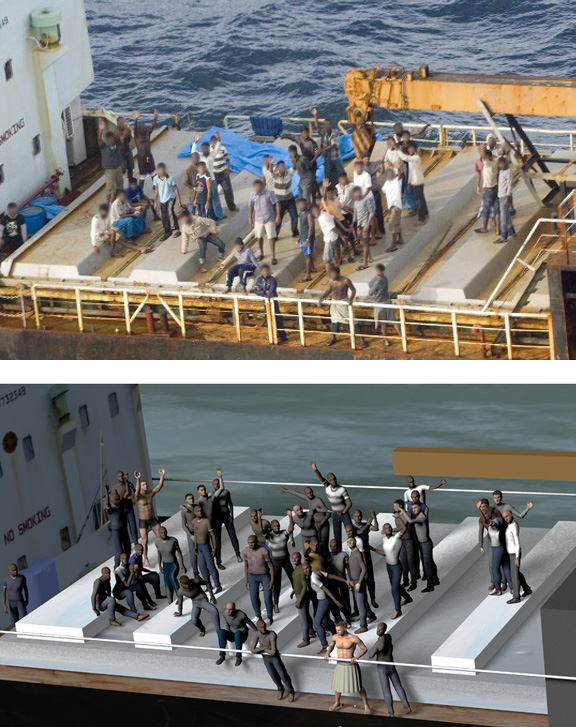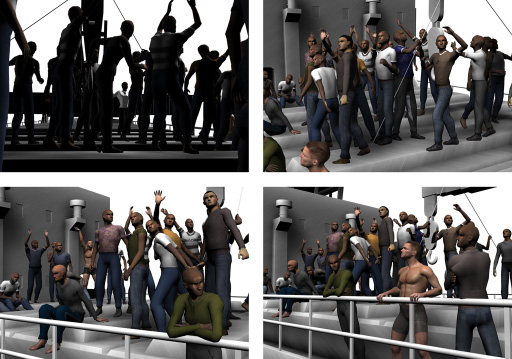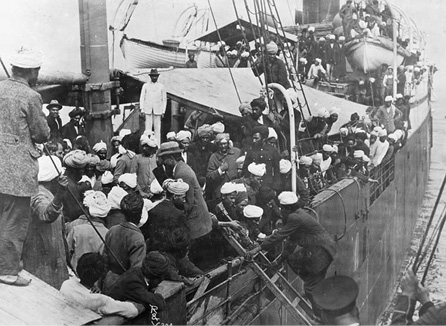RE-CREATION, REALISM AND RACE IN POST-DIGITAL PHOTOGRAPHY
This text brings together some loosely connected thoughts on my project, a multi-media re-creation of a migrant ship’s arrival at the coast of British Columbia, Canada. I intend to argue that photography, in spite of its recent technological advances and democratization, has devolved inadequately to address the significance of its subjects, in particular where it concerns photojournalism and subjects of race and migration. I propose artistic re-creation as an alternative to straight photography — re-creation has the potential to retain the political gravity of important events. Finally, I will relate how I was surprised to discover a form of digital racism in a piece of software used in my creative process.
1
I am a photo-based artist who works in a tenuous relationship with photography. I now rarely make photographs as a finished form. I started working with photography at a time when digital photography started to become pervasive. By this, I don’t mean that digital photography simply replaced the function of film or analogue photography. Rather, digital imaging has irreversibly and fundamentally changed our lives and our relationships to images. I began noticing a change in how news media were using photography to illustrate articles. At first, I noticed the increased use of file photographs, such as a typical stock image of handcuffs or the usual police tape accompanying nearly any given crime story. Then, I frequently saw that amateur and low-resolution photography, such as the kind made on a phone or captured from security camera footage, was supplanting the more aesthetic practices of photojournalism historically exemplified by figures such as Henri Cartier-Bresson, Lee Miller, or more recently, the war zone embedded freelance photographer. The professional/auteur was quickly finding him or herself replaced by crowd-sourcing and automated drones. It could be argued that this signals the democratization of photography and that these images bring attention to stories that might otherwise go unnoticed, but it also sometimes seems that the increasingly casual and passive direction of these practices and images does not do justice to the gravity of the stories and the events they are intended to depict, and furthermore, might devalue these stories and events.1
2
This downward shift in photographic quality is one point of entry into my Migrant Ship Re-creation Project, in progress since 2009. My work here is comprised of a model ship and several renderings of figures made using 3D software. These works are a part of a larger, unfinished, and still largely undefined project to re-interpret and re-create such a press image, one that was used to illustrate an important event that concerns race and migration.2
In 2009, Canadian authorities seized the MV Ocean Lady in the waters near Victoria, British Columbia and detained its crew and passengers who undertook a dangerous journey to seek asylum in Canada. There was, and continues to be, massive public debate and speculation over the legality of their claims and the practice of human smuggling. A climate of xenophobia has developed amidst accusations of immigration “queue-jumping” and fears of terrorism.
The extensive media coverage of the Ocean Lady story was frequently accompanied by a particular low-resolution digital photograph that depicts the passengers on the deck of the ship. I found this photograph very compelling despite (or perhaps because of) its lack of quality and information. I found this image especially interesting in contrast to other photographs of related events such as the Komagata Maru incident or the migrant ships from Fujian, China in 1999.
The first thing that struck me about this image was the unusual overhead angle, indicating it was likely taken from a helicopter or by a drone. It seems oddly and arbitrarily cropped, perhaps also suggesting there is more to the image than was released to the public. Moreover, there is a compressed sense of perspective making everything look flat. All of this contributes to a depiction that contrasts with the conventional eye-level viewpoint that dominates most photography. The second thing I noticed is the heavily compressed, pixilated nature of the image. Until most recently, photography has been dominated by an impulse to produce ever sharper and clearer images. The pixilated quality increases the contrast and saturation of the image, making it look somewhat cartoonish. My third observation is that this severe pixilation and subsequent blurring removes the individuals’ identities. It could be said that their particular features, as represented by a collection of pixels, are reduced to a common “brown” wash that paints each migrant with the same brush. And yet I could still easily make out details such as clothing and hairstyles. I could still read the expressions on their faces, imagine what they look like and understand their gestures.

Tamil migrants photographed on deck of the MV Ocean Lady. Submitted photo/RCMP Federal Border Integrity Program files (top); Evan Lee, Migrant Ship Re-creation Project, 2009-14, detail
By my count there are forty-some figures shown, appearing completely candid and unposed. There is nothing deliberate, and therefore nothing unifying, in their appearance or actions. The scene seems random and uneventful, despite the grave circumstances. Perhaps inexplicably, I felt this photograph was problematic if it was to be the only record of this moment.3 This lead me to re-imagine and re-create this event as an artwork with hopes of restoring some of the gravity of the situation along with unseen qualities of the moment and other neglected aspects.
3
During my research, I started looking at Théodore Géricault’s 1819 painting The Raft of the Medusa, which depicts the last survivors from the French naval ship Medusa, which ran aground off the coast of West Africa in 1816. After 13 days of starvation, disease and desperation, which reportedly led to cannibalism, the survivors on this makeshift raft vainly attempt to flag a passing ship.4 My intention is not to make a comparison between The Raft of the Medusa and the MV Ocean Lady, but to suggest the former as an example of how to successfully memorialize an important and potentially sensitive event through the act of re-creation, rather than capturing it as a passive recording of an event.
Géricault made the unexpected choice of taking a relatively contemporary news story as a subject during a time when paintings were normally made to celebrate classical and/or grand historical events. Instead of relying on classical forms and models, Géricault chose to re-create his scene from scratch, and in doing so, he arguably achieved a unique sense of realism. With no pre-existing depictions of the event, the artist had to rely on the accounts of the survivors for descriptions and details. He had carpenters build a replica of the raft and then he posed both models and corpses in his studio.

Theodore Géricault, The Raft of the Medusa, 1819
There is an unmistakable and theatrical drama present in this painting that is difficult to buy into as being real with our post-photo/post-digital eyes and it stands in stark contrast to the banal realism of the MV Ocean Lady press image. However, if the technology were available 200 years ago, at the time and place of the Medusa shipwreck, would a photographer with a camera, let alone a flying drone or someone sailing by with an iPhone, make a better picture?
4
On one level, my project proposes a critique of photography’s current state, but it is really more concerned with migration and racism. Admittedly, the screen of photography gives me the opportunity to work with a history that isn’t directly mine; I am not a migrant, but most of my family and friends are, and so the issues, and where they overlap those of race and identity, are close to me.
Another aspect of my project was to work creatively with very limited source materials and strategies to reconstruct, not only the situation on the ship not visible in the press image, but also the blurred-out faces of the individuals on the ship. At first I tried to interpolate from what features I thought I could see in the pixels from the original press image and apply those somewhat-imagined features to 3D-modeled figures. Then I went looking online for reference images. As time passed, new and uncensored images of the migrants emerged. I began combining all this material to make portraits of migrants that are actually ongoing composites of fact and invention, real and virtual.

Evan Lee, Migrant Ship Re-creation Project, 2009-14, studies
My initial reason for turning to software to make a 3D model was to change the very odd viewpoint of this picture. I thought a more conventional point of view would bring the audience into a more meaningful relationship with the scene. This is something we see in Géricault and in some of the archival Komagata Maru photographs. Using software, I re-created the scene in the original press image by creating, placing and posing figures. Having accomplished this, I could then rotate, zoom and view the scene from any angle. The posing software works like this: let’s say I need to draw or visualize a figure — rather than build a unique person from scratch, I select a figure from a number of prototypes, such as “Victoria”, “Aiko” or “Mike”, whose bodies tend to be idealized by default, serving the superhero or fantasy art genre, or gaming and animation needs. Posing with digital software functions much like working with an actual wooden artist’s mannequin, but the software poses provide much greater detail, including movements for each finger joint and the ability to change the shape of the mouth to speak specific sounds and to make facial expressions such as a smile.

Komagata Maru, Vancouver, Burrard Inlet, 1914, Library and Archives Canada
Although the possibilities of such technologies are almost limitless, as demonstrated by movies and video games, there was only a limited amount of customization available to me given the steep learning curve and the limits of the software, which was a free download. Because originally I was only interested in a reference for visualizing and sketching in the studio, I wasn’t really interested in creating a hyper-realistic, immersive 3D world. I discovered that I sort of liked how the figures were all stiff looking clones of one another, like in older video games.
As this aspect of the project developed, I was rather surprised to discover inadvertent racism in the design of the 3D software. With some dials located on the side panel, I could adjust the figures to take on a variety of characteristics: tall, short, fat, skinny or more muscular. I could give them different hairstyles or put them in different clothes. I could also change their overall skin colour. Here lie some potentially troubling racial implications: not only could I change their pigmentation at the push of a button, I could also “dial in” how “Chinese” or “African” the facial features will be. Going past 100 percent — which the program does allow — results in racial caricatures or stereotypes as features such as the shapes of the eyes, nose and lips become grossly exaggerated. One can only assume, from the appearance of the original figure and the absence of any other adjustments for ethnicity, that the default setting was Caucasian. I assume the creators didn’t intend for their program to be scrutinized like this, but they probably also didn’t think it would be used to re-create a politically charged historical event. However, for the purposes of the present text and the accompanying symposium with the title, Disfiguring Identity, I couldn’t help but briefly address this disturbing discovery that held implications for how my project would turn out.
I began this project with a singular vision of how I would re-create a found news photograph of the Ocean Lady migrant ship and address what I perceived as the media’s (as well as the medium’s) shortcomings in presenting its story. As the migrants’ stories continue to unfold while racist attitudes towards them remain unchanged and new prejudices emerge, my unfinished project continues to evolve in response, taking on myriad and unexpected forms. Migrants will continue to move from one part of the world to another, where they will be welcomed by some, but resisted by others. There will be another imaging or recording technology that will frame their history in a particular way while purporting to present the truth about it, and so we need alternative ways of presenting these stories. It may go against reason that a creative and oblique approach would be less biased, but as we have seen from my research and use of digital photography and 3D modelling, there are peculiar and often overlooked constraints and features embedded in the technologies themselves that deeply affect the appearance of the scenes they depict. Nevertheless, innovative works of art that simultaneously embrace and critique such technology — or in the case of Géricault’s The Raft of the Medusa, which perhaps did not challenge the limitations of its medium so much as those of its academically prescribed genre — can present surprisingly acute perspectives on these events.
NOTES
1. Take for example the ubiquitous security camera stills showing Trayvon Martin in a convenience store before his shooting, or, more locally, phone images of a toddler urinating into a trash receptacle at a shopping mall and of a man vandalizing the Komagata Maru monument in Coal Harbour that widely circulated in first social, then mainstream media.
2. I’ve also expanded this project to include a re-creation of a similar press image from 1999 depicting the arrival of migrants from Fujian, China. The work in the present exhibition includes materials from both events.
3. I’m interested in images of this moment of first contact, as opposed to images made after the ship had been detained, boarded, etc.
4. Incidentally, there have been many interpretations of this work that are centered on discussions of race and the artist’s role as an abolitionist.
Images courtesy author






